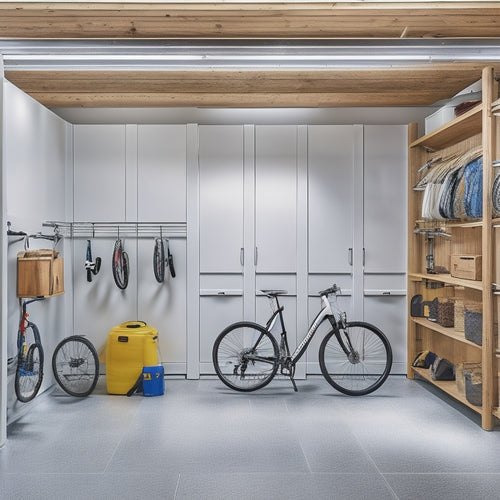
Prioritize Your Woodworking Tasks for Maximum Efficiency
Share
To prioritize your woodworking tasks for maximum efficiency, start by identifying and organizing tasks by urgency and importance. Break down large tasks into smaller, manageable chunks, and eliminate non-essential activities that drain your time and energy. Focus on high-impact projects that drive revenue and showcase your innovative design skills. Group similar tasks together to minimize setup and teardown times, and use a task priority matrix to visualize and categorize your tasks. By streamlining your workflow, you'll free up more time to focus on what matters most. Now, take the next step to optimize your workflow and reveal your full potential.
Key Takeaways
• Identify and prioritize high-impact projects, focusing on urgent and important tasks to maximize efficiency and productivity.
• Break down large tasks into smaller, manageable chunks, and organize them by urgency and importance to ensure a clear workflow.
• Eliminate non-essential tasks and focus on essential actions that drive project progress, saving time and energy in the process.
• Group similar tasks together to minimize setup and teardown times, optimize workspace organization, and increase overall efficiency.
• Use a task priority matrix to visualize and categorize tasks, enabling better decision-making, increased productivity, and reduced stress.
Prioritize Tasks by Deadline
When working on multiple woodworking projects simultaneously, prioritize tasks by deadline to guarantee you meet critical timelines and avoid costly delays. Effective time management is vital to completing projects on schedule.
Start by identifying the tasks that need to be completed for each project, and then organize them based on their urgency and importance. Create a schedule that outlines the tasks you need to complete each day, and allocate specific time slots for each task. This will help you stay focused and make certain that you're making progress on all projects.
Good task organization is also essential to prioritizing tasks by deadline. Break down large tasks into smaller, manageable chunks, and prioritize them based on their deadlines. Use a calendar or planner to keep track of your tasks and deadlines, and make adjustments as needed.
Focus on High-Impact Projects
When focusing on high-impact projects, you'll want to tackle the ones that bring in the most revenue first. This strategy guarantees you're maximizing your earnings and setting yourself up for success.
Highest Revenue Projects First
By addressing your highest revenue projects first, you'll maximize your earnings and set yourself up for long-term financial success in your woodworking business. This approach guarantees that you're dedicating your time and resources to the projects that will generate the most profit.
Focus on high-impact projects that showcase your innovative design skills and offer cost-effective solutions to clients.
Some key factors to take into account when prioritizing your highest revenue projects include:
-
Time sensitive orders: Prioritize projects with urgent deadlines to guarantee timely delivery and maximize revenue.
-
Custom creations: Focus on bespoke projects that command higher prices due to their unique nature.
-
High-demand products: Identify products with high market demand and prioritize their production to capitalize on the trend.
-
Repeat business: Prioritize projects from repeat clients or those with potential for future collaborations.
-
High-margin projects: Focus on projects with high profit margins to maximize your earnings.
Most Urgent Deadlines Next
After maximizing revenue with your highest-paying projects, you can now shift your attention to tackling projects with the most urgent deadlines, guaranteeing timely delivery and maintaining a strong reputation for reliability. This focus on high-impact projects is essential in effective time management, as it allows you to allocate your resources wisely and meet critical deadlines.
By prioritizing tasks based on their urgency, you'll avoid last-minute rushes and reduce the likelihood of costly delays. Effective task prioritization is key to managing your workload efficiently. Identify the projects with the closest deadlines and break them down into manageable tasks.
Create a schedule that outlines specific tasks to be completed each day, and stick to it. This will help you stay focused and make sure that you're making progress on your most urgent projects. Remember, timely delivery is crucial in building trust with your clients and maintaining a strong reputation in the woodworking industry.
Break Down Large Tasks
When you're faced with a large woodworking project, it's crucial to break it down into manageable components.
You'll want to identify the individual parts that make up the project, then divide each part into smaller, actionable steps.
Identify Project Components
You'll need to break down your large woodworking project into smaller, manageable components to guarantee a clear understanding of the tasks involved and to create a realistic timeline for completion. This process allows you to visualize the project's scope, identify potential roadblocks, and make adjustments before you start building.
Here are some key components to ponder when breaking down your project:
-
Material selection: Identify the types and quantities of wood, hardware, and other materials needed for the project.
-
Tool preparation: Determine which tools are required and make sure they're in good working condition.
-
Design considerations: Review your design plans, taking into account factors like measurements, joints, and finishes.
-
Time management: Estimate the time required for each task, taking into account your skill level, available work hours, and any deadlines.
-
Specialized tasks: Identify any specialized tasks, such as carving or upholstery, that may require additional skills or expertise.
Divide Into Smaller Steps
Breaking down large tasks into smaller, actionable steps is crucial to ensuring a smooth workflow and avoiding project paralysis. By doing so, you'll be able to tackle each step with confidence, making steady progress towards completing your woodworking project. This approach also helps with time management, as you can allocate specific times for each step, ensuring you stay on track.
To break down large tasks, try the following:
| Task | Smaller Steps | Estimated Time |
|---|---|---|
| Build a cabinet | Cut lumber, assemble frame, attach shelves | 4 hours |
| Sand and finish | Sand all surfaces, apply stain, apply polyurethane | 3 hours |
| Install hardware | Attach handles, install hinges, add shelf pins | 1 hour |
| Add a back panel | Cut panel to size, attach to cabinet | 1 hour |
| Final assembly | Assemble all components, add finishing touches | 2 hours |
Eliminate Non-Essential Tasks
Prioritize your woodworking project by identifying and eliminating tasks that don't greatly impact the final outcome, freeing up time and energy for what truly matters. This task evaluation is pivotal in effective time management.
By focusing on essential tasks, you'll avoid wasting time on non-essential activities that can derail your project's progress.
Here are some non-essential tasks to eliminate:
- Polishing a piece to perfection when it's only a prototype
- Using expensive materials for a project that's meant to be a practice run
- Spending hours researching a technique when a simpler method will suffice
- Creating intricate designs when a simple one will do
- Over-accessorizing a project when it's not necessary for its functionality
Group Similar Tasks Together
By categorizing similar tasks together, such as all the sanding or cutting tasks, you can tackle them in one session, thereby minimizing setup and teardown times, and increasing overall efficiency.
This approach allows you to optimize your workspace and tool organization, ensuring that everything you need is within easy reach.
For instance, if you're working on a project that requires multiple cuts, group all the cutting tasks together and complete them in one go. This way, you won't have to constantly switch between tools or reconfigure your workspace, saving you time and effort.
Additionally, grouping similar tasks together enables you to maintain a consistent workflow, reducing the likelihood of errors and mistakes.
As you work on your project, you'll find that this approach streamlines your process, allowing you to complete tasks quickly and efficiently.
Use a Task Priority Matrix
You can further optimize your woodworking task management by using a task priority matrix, which helps you visualize and categorize tasks based on their urgency and importance. This matrix is a powerful tool for effective time management, allowing you to focus on the most critical tasks that drive task efficiency.
To create a task priority matrix, divide a piece of paper or a digital document into four quadrants. Label the axes as 'Urgency' and 'Importance.' Then, plot each task on the matrix according to its level of urgency and importance. This will help you identify which tasks require immediate attention and which ones can be delegated or postponed.
Here are some benefits of using a task priority matrix:
-
Clearer task visualization: See all your tasks in one place and understand their relationships.
-
Improved task categorization: Group tasks into four categories: urgent & important, important but not urgent, urgent but not important, and not urgent or important.
-
Better decision-making: Make informed decisions about which tasks to focus on first.
-
Increased productivity: Maximize your time management by tackling high-priority tasks first.
-
Reduced stress: Feel more in control of your workload and reduce stress by breaking down complex tasks into manageable chunks.
Consider Task Urgency Level
When evaluating tasks, assess the urgency level of each one, considering deadlines, time-sensitive dependencies, and potential consequences of delay or inaction. You want to prioritize tasks that have a significant impact on your woodworking project's timeline and success.
| Task | Urgency Level | Priority |
|---|---|---|
| Completing the table top | High | Must-do today |
| Sanding the table legs | Medium | Should-do this week |
| Building a new workbench | Low | Nice-to-do soon |
| Creating a custom design | High | Must-do this month |
| Organizing your workshop | Medium | Should-do next week |
Consider the task importance, complexity, and skill level required to complete each task. Additionally, think about the resources needed, such as materials, tools, and equipment. By evaluating these factors, you'll be able to assign an appropriate urgency level to each task. Remember, prioritizing tasks based on their importance ensures you're focusing on the most critical tasks first, maximizing your efficiency and productivity in your woodworking project.
Schedule Regular Break Times
Now that you've prioritized your tasks, it's equally important to schedule regular break times to recharge and maintain focus throughout your woodworking project. Taking mindful breaks can significantly boost your productivity and overall efficiency.
Without breaks, you may find yourself burning out, leading to decreased motivation and a higher risk of errors.
Here are some tips to help you schedule effective break times:
- Set a timer to remind you to take breaks every 60-90 minutes
- Use your breaks to stretch, move around, and rest your eyes
- Take a brief stroll outside to refresh your mind and get some natural light
- Use breaks to review your progress, adjust your plan if needed, and refocus on your goals
- Make breaks a habit by incorporating them into your time management strategy
Frequently Asked Questions
How Do I Handle Unexpected Tasks That Arise During a Project?
"When unexpected tasks ambush your project, don't let them hijack your timeline! You're a master juggler - handling interruptions with ease, adjusting your schedule on the fly, and flexing your task list to stay on track."
What if I Have Multiple Tasks With the Same Deadline and Importance?
When faced with multiple tasks of equal importance and deadline, you'll need to employ sharp time management and decision making skills to allocate resources effectively, considering task delegation and project planning strategies to meet your goals.
Can I Prioritize Tasks Based on Personal Interest and Enjoyment?
"You can prioritize tasks based on personal interest and enjoyment, as it boosts motivation and productivity. When you're passionate about a task, you'll manage your time more efficiently and stay focused, achieving more in less time."
How Do I Prioritize Tasks When Working on a Team or With a Partner?
"When working with a partner or team, you're the conductor of a harmonious orchestra, ensuring each player's melody blends seamlessly. Foster open team dynamics and communication, delegate tasks effectively, and collaborate with your partner to create a symphony of success."
What if I'm Not Sure How Long a Task Will Take to Complete?
When you're unsure how long a task will take, estimate the time realistically, leaving room for flexibility, and break it down into smaller, manageable chunks to help you stay on track and adjust as needed.
Related Posts
-

Best Organizing Tools for a Clutter-Free Space
You're on a mission to change your cluttered space into a peaceful oasis, and you're looking for the best organizing ...
-

Small Shelving Options for Tight Spaces
You're surrounded by tight spaces in your home, and you need clever shelving solutions that optimize storage without ...
-

Modular Garage Organizers for Clutter-Free Spaces
You're likely wasting precious space in your garage due to inefficient storage and poor organization, but modular gar...


